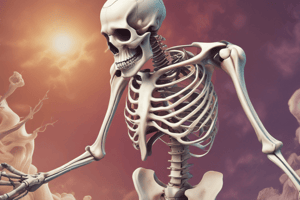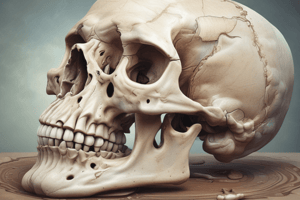Podcast
Questions and Answers
What is a key factor in identifying high-risk patients for MRONJ?
What is a key factor in identifying high-risk patients for MRONJ?
- History of osteoporosis, cancer, or Paget's disease (correct)
- History of dental caries
- Family history of MRONJ
- Long-term use of antibiotics
What is a recommended approach to optimize medication use in patients at risk of MRONJ?
What is a recommended approach to optimize medication use in patients at risk of MRONJ?
- Use the highest dose of bisphosphonates and denosumab to ensure maximum efficacy
- Discontinue medication use altogether
- Use alternative medications with higher risk of MRONJ
- Use the lowest effective dose and duration of bisphosphonates and denosumab (correct)
What is a recommended step in optimizing oral health before medication initiation?
What is a recommended step in optimizing oral health before medication initiation?
- Postpone dental treatment until after medication initiation
- Complete dental treatment plans before starting medications (correct)
- Extract all teeth to prevent future dental problems
- Use antibiotic prophylaxis before medication initiation
What is a recommended approach to optimize surgical techniques in patients at risk of MRONJ?
What is a recommended approach to optimize surgical techniques in patients at risk of MRONJ?
What is a recommended step in optimizing post-operative care in patients at risk of MRONJ?
What is a recommended step in optimizing post-operative care in patients at risk of MRONJ?
What is a recommended adjunct to enhance healing in patients at risk of MRONJ?
What is a recommended adjunct to enhance healing in patients at risk of MRONJ?
What is the primary inspiration behind the development of deep learning models?
What is the primary inspiration behind the development of deep learning models?
What is the primary benefit of using random forests in machine learning?
What is the primary benefit of using random forests in machine learning?
What is the primary difference between feedforward neural networks and recurrent neural networks?
What is the primary difference between feedforward neural networks and recurrent neural networks?
What is the primary goal of language modeling in natural language processing?
What is the primary goal of language modeling in natural language processing?
What is the primary advantage of using convolutional neural networks (CNNs) in image recognition tasks?
What is the primary advantage of using convolutional neural networks (CNNs) in image recognition tasks?
What is the primary purpose of tokenization in natural language processing?
What is the primary purpose of tokenization in natural language processing?
Flashcards are hidden until you start studying
Study Notes
MRONJ (Medication-Related Osteonecrosis of the Jaw) Optimization
Risk Factors Optimization
- Identify high-risk patients:
- History of osteoporosis, cancer, or Paget's disease
- Long-term use of bisphosphonates, denosumab, or anti-resorptive medications
- Older age, female gender, and smoking
- Optimize medication use:
- Use lowest effective dose and duration of bisphosphonates and denosumab
- Consider alternative medications with lower risk of MRONJ
Dental Care Optimization
- Optimize oral health before medication initiation:
- Complete dental treatment plans before starting medications
- Remove teeth with poor prognosis or active infection
- Ensure good oral hygiene and regular dental follow-up
- Avoid invasive dental procedures during medication use:
- Postpone non-essential dental procedures until medication use is discontinued
- Use antibiotic prophylaxis before invasive dental procedures
Surgical Optimization
- Optimize surgical techniques:
- Use gentle tissue handling and minimal trauma to bone and soft tissues
- Avoid bone cutting and drilling during surgical procedures
- Use platelet-rich fibrin (PRF) or platelet-rich plasma (PRP) to enhance healing
- Optimize post-operative care:
- Use gentle oral rinses and avoid traumatic oral hygiene practices
- Monitor for signs of MRONJ and provide prompt treatment if necessary
MRONJ (Medication-Related Osteonecrosis of the Jaw) Optimization
Risk Factors Identification
- History of osteoporosis, cancer, or Paget's disease increases risk of MRONJ
- Long-term use of bisphosphonates, denosumab, or anti-resorptive medications is a key risk factor
- Older age, female gender, and smoking are additional risk factors
Medication Use Optimization
- Use lowest effective dose and duration of bisphosphonates and denosumab to minimize risk
- Consider alternative medications with lower risk of MRONJ
Dental Care Optimization
- Complete dental treatment plans before starting medications to reduce risk of MRONJ
- Remove teeth with poor prognosis or active infection to prevent complications
- Ensure good oral hygiene and regular dental follow-up to maintain optimal oral health
- Postpone non-essential dental procedures until medication use is discontinued to minimize risk
- Use antibiotic prophylaxis before invasive dental procedures to prevent infection
Surgical Optimization
- Gentle tissue handling and minimal trauma to bone and soft tissues reduces risk of MRONJ
- Avoiding bone cutting and drilling during surgical procedures minimizes trauma
- Using platelet-rich fibrin (PRF) or platelet-rich plasma (PRP) enhances healing and reduces risk
- Gentle oral rinses and avoiding traumatic oral hygiene practices post-operatively reduce risk
- Monitoring for signs of MRONJ and providing prompt treatment if necessary is crucial
Deep Learning
- Models and solves complex problems using artificial neural networks inspired by the human brain
- Key applications include:
- Image recognition
- Speech recognition
- Natural language processing
- Game playing, such as AlphaGo
Random Forests
- An ensemble learning method that combines multiple decision trees to improve prediction accuracy and stability
- Each decision tree is trained on a random subset of:
- Features
- Samples
- The final prediction is made by aggregating individual tree predictions
- Key benefits include:
- Handling high-dimensional data
- Reducing overfitting
- Improving predictive accuracy
Neural Networks
- A machine learning model inspired by the human brain's structure and function
- Composed of layers of interconnected nodes (neurons) that process and transmit information
- Key types of neural networks include:
- Feedforward neural networks
- Recurrent neural networks (RNNs)
- Convolutional neural networks (CNNs)
- Applications include:
- Image recognition
- Speech recognition
- Natural language processing
- Game playing, such as AlphaGo
Natural Language Processing (NLP)
- A subfield of artificial intelligence that focuses on human-computer language interaction
- Key tasks include:
- Language modeling
- Text classification
- Sentiment analysis
- Machine translation
- Techniques used in NLP include:
- Tokenization
- Part-of-speech tagging
- Named entity recognition
- Dependency parsing
Studying That Suits You
Use AI to generate personalized quizzes and flashcards to suit your learning preferences.




